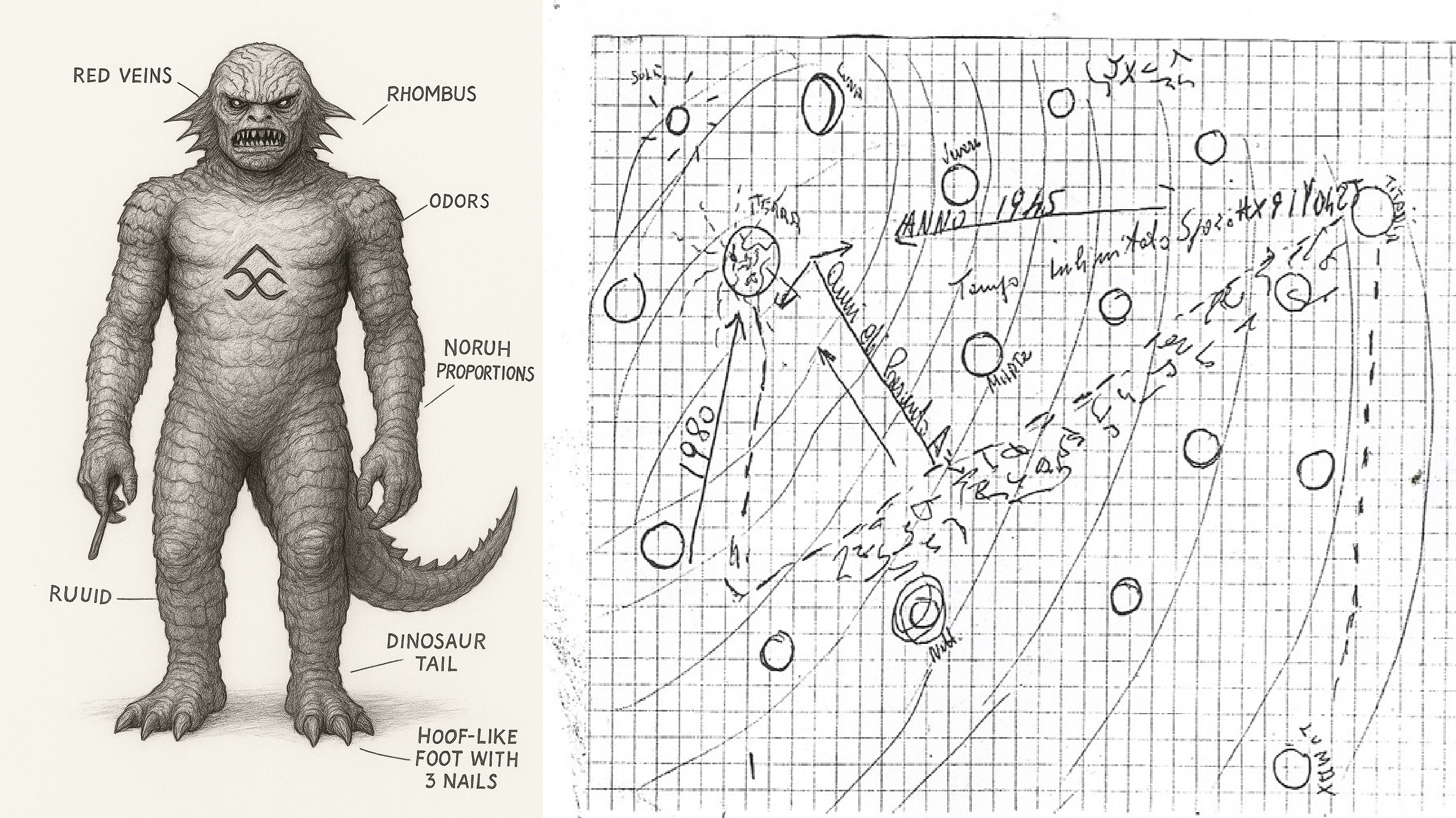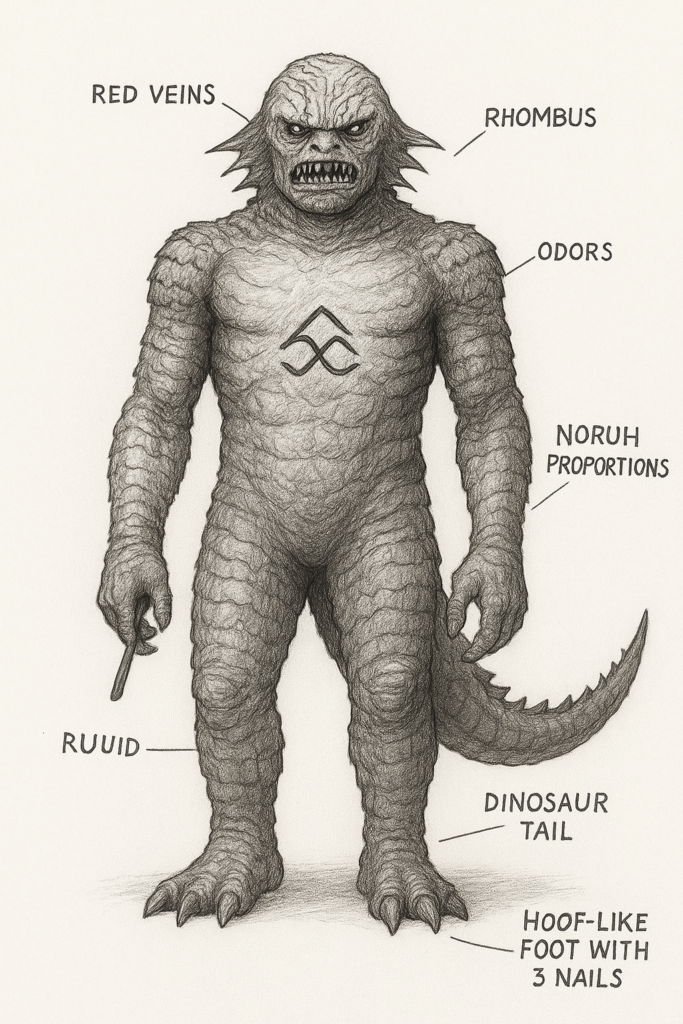When the first humans stepped onto the Moon in 1969, it changed how people looked at the night sky. The success of the Apollo missions showed that travel between worlds was possible. Yet, after the Moon landings ended in 1972, another kind of curiosity began to rise. Across the world, reports of strange lights, objects, and unknown visitors increased. The idea that someone might be watching us from space slowly took root.

In this climate of fascination and fear came the case of Fortunato Zanfretta, a night guard from Torriglia, near Genoa in northern Italy. Between 1978 and 1981, he reported a series of encounters that would become one of Europe’s most debated UFO mysteries. Zanfretta said that on a December night in 1978, while patrolling near a villa, his car was suddenly engulfed by a green light. He stopped, stepped out, and saw enormous beings—reptile-like creatures more than four meters tall, with rough green skin, red veins across their heads, and a glowing diamond-shaped mark on their chests. The heat around them was strong, and the air smelled strange. He said he could not move, as if frozen in place, until the creatures vanished in a flash of light.


The story quickly reached Italian newspapers, and within months he became a national figure. Police found his fear genuine; under hypnosis, he repeated the same story in detail. Over the next three years, Zanfretta reported several similar events. Along with his statements came drawings—sketches that looked part diary, part cosmic map. On these pages he wrote words like “Lumax,” “8th Galaxy,” “Titan,” “Saturno,” “Luna di Giove,” and “Terra 1980.” Arrows connected circles that seemed to represent planets, tracing a path from the outer solar system toward Earth.
The timing of these drawings is remarkable. While Zanfretta described beings from the “8th Galaxy,” NASA’s Voyager 1 and Voyager 2 spacecraft were at that very moment transforming humanity’s view of the outer solar system. Between 1979 and 1981, they sent back the first close-up images of Jupiter, its moons, Saturn, and Titan. The world learned that Titan had a dense orange atmosphere, and that Jupiter’s moons like Io and Europa were active and complex. The same names that appeared in Zanfretta’s sketches were suddenly appearing in scientific headlines. Whether coincidence or not, the overlap between his notes and real discoveries drew attention even from skeptics.
In one of the most studied drawings, Zanfretta wrote “8ª Galassia Lumax.” The word Lumax sounds like the Latin lumen, meaning light. Some have compared it with the Fornax Dwarf Galaxy, one of the Milky Way’s nearest neighbors, whose name literally means furnace. Fornax is sometimes listed as the eighth-closest galaxy to ours. The similarity between Lumax—a word linked to brightness—and Fornax, associated with heat and light, led some researchers to wonder if his “8th Galaxy Lumax” was a symbolic reference to something luminous and distant.
Another of his drawings shows a route made of arrows: Lumax → Titan → Moon of Jupiter → Moon → Earth. It looks like a travel map leading inward through the solar system. The year “1980” appears beside Earth, the same year Voyager reached Saturn. For believers, this alignment feels deliberate—a sign that Zanfretta’s “visitors” were following a cosmic route that mirrored humanity’s own path of exploration.

The creature itself, as Zanfretta described and drew it, is detailed and consistent. It is upright, muscular, rough-skinned, with three large claws on each foot and a tail “like a dinosaur’s.” The proportions, however, are not animal-like but humanoid. This design fits what later became known as the “reptilian” archetype—a race of tall, intelligent, lizard-like beings often mentioned in UFO and mythological accounts. Zanfretta’s reports came before the term “reptilian” became common, which makes the resemblance striking. Supporters argue that he could not have been copying an idea that had not yet spread; skeptics believe the image drew unconsciously from ancient serpent myths or science-fiction influences.

Some scientists have imagined that if dinosaurs had not gone extinct, a species like Troodon might have evolved into a tool-using, intelligent creature. In that light, Zanfretta’s being could be seen as a vision of what an advanced reptile might look like—something plausible, if not proven. Yet there is no fossil or biological evidence of such life, either on Earth or elsewhere.
The years following the Moon landings were also filled with rumors about NASA astronauts seeing unknown craft or “beings” on the lunar surface. A popular story claimed that Neil Armstrong warned, “Don’t look at them; they’re watching us.” However, the complete Apollo recordings—publicly available for decades—contain no such words. The quote has never appeared in any official transcript. Still, stories like that created an atmosphere of mystery. To many, it seemed that if humans could walk on the Moon, perhaps others could too. This feeling of hidden truth made Zanfretta’s case more believable to those who already suspected something was being concealed.
The late 1970s and early 1980s saw a wave of UFO sightings worldwide. It was a period of technological optimism and deep uncertainty: the space age had opened new horizons, but many questions about what lay beyond remained unanswered. Zanfretta’s story, arriving during that era, reflected both fascination with science and fear of the unknown. His words and drawings captured the imagination of a generation that was beginning to see space not just as empty, but as potentially inhabited.
Investigators who reviewed his case found no signs of fraud. His co-workers confirmed strange lights on the nights he reported encounters. Police found marks on the ground where he said craft had landed, though none could be linked definitively to any machine. The case eventually closed without explanation, leaving behind only his testimony and his remarkable sketches.
When viewed together, the coincidences are difficult to ignore: the timing with Voyager’s discoveries, the names matching newly explored moons, the bright “Lumax” galaxy, the map of travel pointing toward Earth, and the detailed humanoid reptile form. For those who see patterns, it all appears to form a single line of meaning—a message or memory that connects distant worlds to our own.
Even so, no scientific evidence confirms the existence of reptilian beings, the Lumax galaxy as a place of origin, or contact between humans and such species. The drawings remain a mystery, bridging the space between imagination and discovery. They remind us how the human mind connects new knowledge with old myths, creating stories that mirror both fear and wonder.
The Zanfretta mystery continues to be studied not just as a UFO case, but as a symbol of how the space age reshaped human belief. It stands at the meeting point of astronomy, folklore, and psychology—where the boundaries between what we see and what we dream often become one.
I don’t know what each of you will believe after reading this story — whether you see it as evidence, coincidence, or simply imagination. What I do know is that curiosity never dies. It is the same force that sent humans to the Moon, that made us send probes to Saturn and Jupiter, and that still makes us look up and wonder who else might be looking back. Whether the truth lies in science, myth, or somewhere in between, the search itself keeps our minds alive — and perhaps, that is what the universe wants most from us.

